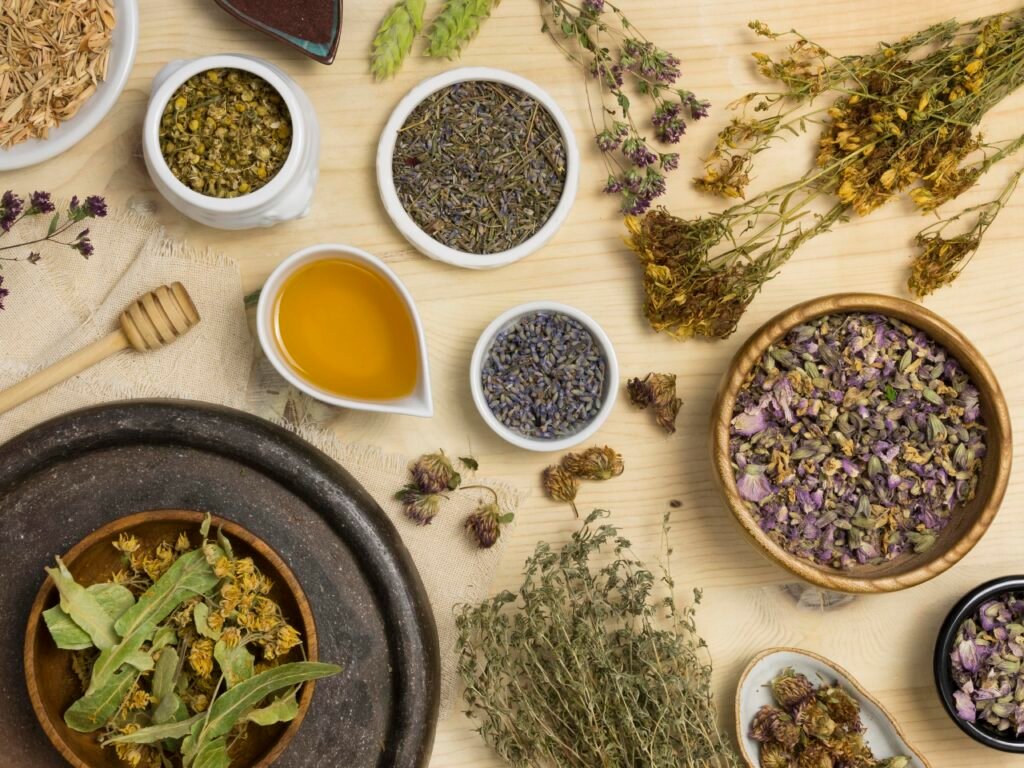WHAT ARE HERBS ?
Herbs are plants with fragrant or aromatic properties. Herbs can be used to flavor food, included in fragrances, and even a part of natural medicines. Basil, parsley, rosemary, thyme, and dill are all herbs.
Herbs are the leaf part of a plant that is used in cooking – these can be used fresh or dried.
The Difference between Herbs and Spices

The essential difference between herbs and spices lies with what part of the plant they originated from. An herb is a leaf or other green plant of the plant.
Any other part of the plant, which is usually dried, is referred to as a spice.
For example, berries (peppercorns), roots (turmeric), flowers (chamomile) and stigmas of flowers (saffron) , cinnamon is the bark of a tree. Cardamom & Cumin is a seed pod. Allspice is a dried berry. Cloves are dried flower buds. These are all examples of spices.
Spices are used in dried form while herbs can be used either fresh or dried.
Health benefits of herbs
Consuming herbs may help to prevent and manage heart disease, cancer, diabetes and many more properties. It may also help to reduce blood clots and provide anti-inflammatory and anti-tumor properties. Research is ongoing but studies have shown that:
- Garlic, linseed, fenugreek and lemongrass may help lower cholesterol.
- Garlic is useful for people with mildly elevated blood pressure.
- Fenugreek can help control blood sugar and insulin activity (as can linseed, flaxseed and cinnamon).
- Garlic, onions, chives, leeks, mint, basil, oregano, sage and many other herbs can help protect against cancer.
- Herbs are rich in antioxidants, especially cloves, cinnamon, sage, oregano and thyme, by helping to reduce low-density lipoproteins (‘bad’ cholesterol).
Fresh herbs often contain higher antioxidant levels compared to processed or dried herbs. If you are using herbs in order to harness their health-promoting aspects first and foremost, aim to add your fresh herbs at the end of cooking or as you serve to preserve these properties.
How to Cook With Herbs

Many recipes will call for herbs as an ingredient.
Dried herbs are often added during the cooking process and may be included to impart flavor while cooking. Common dried herbs include oregano, rosemary, sage, and thyme.
Fresh herbs are often added as the last step once cooking has been completed. Fresh herbs bring brightness and fresh flavor to many recipes. Common fresh herbs are mint, cilantro, and parsley.
Some fresh herbs will be one of only a few ingredients in a recipe.
For example:-
A classic pesto recipe relies on fresh basil as the key ingredient. On the other hand, other recipes may call for a simple sprinkling of chopped parsley or cilantro at the end of cooking to bring some bright flavor to the dish.
Healthy Herbs And Food Combinations
There are unlimited ways to use herbs in your cooking. Here are some traditional pairings to get you started:
- basil – pesto, tomato sauce, tomato soup, tomato juice, potato dishes, prawns, meat, chicken and poultry, pasta, rice, egg dishes, strawberries
- bay leaves – soups, stews, casseroles, meat and poultry marinades, stocks
- chilli – meat, chicken and poultry, shellfish, tomato dishes, curries
- chives – salads, chicken, soups, cheese dishes, egg dishes, mayonnaise, vinaigrettes
- coriander – Asian dishes, stir fries, curries, soups, salads, seafood, guacamole
- dill – salads, sauces, fish, sour cream, cheese and potato dishes
- fennel – stuffings, sauces, seafood, salads
- garlic – soups, sauces, pasta, meat, chicken, shellfish, pesto, salad dressings, bread
- ginger – cakes, biscuits, Asian dishes
- lemongrass – Asian dishes, stir fries, curries, seafood, soups, tea
- marjoram – meat, fish, egg dishes, cheese dishes, pizza
- mint – drinks, confectionery, meat, chicken, yoghurt, desserts, sauces, vegetable dishes
- oregano – cheese dishes, egg dishes, tomato sauce, pizza, meat, stuffing, bread, pasta
- parsley – pesto, egg dishes, pasta, rice dishes, salads, butter, sauces, seafood, vegetable dishes
- rosemary – fish, poultry, meat, bread, sauces, soups
- sage – stuffings, tomato dishes, cheese dishes, pumpkin dishes, chicken dishes
- tarragon – salad dressing, egg dishes
- thyme – chowders, bread, chicken and poultry, soups, stock, stews, stuffings, butter, cheese, mayonnaise, mustard, vinegar.
Herb combinations
Some traditional combinations are:
- basil – with chives, chilli, garlic, oregano
- bay – with parsley, thyme, garlic, oregano, marjoram
- chilli – with coriander, garlic, ginger, lemongrass, mint, oregano
- chives – with basil, garlic, tarragon
- dill – with chives, garlic, parsley, tarragon
- garlic – with basil, rosemary, sage, fennel, chilli, coriander
- oregano – with basil, parsley, chives, thyme, bay, chilli
- sage – with rosemary, garlic, marjoram
- thyme – with bay, parsley, garlic, rosemary.
Storing Herbs
Dried herbs should be stored in their sealed jars in a cool, dark, and dry spice cabinet. Fresh herbs will last the longest if they are washed, carefully dried, gently wrapped in a paper towel, sealed into a ziptop bag, and stored in the refrigerator.
